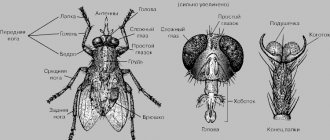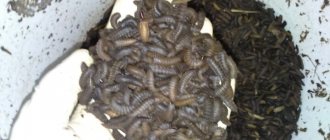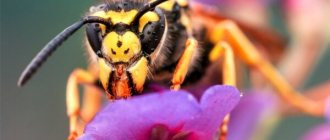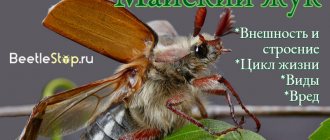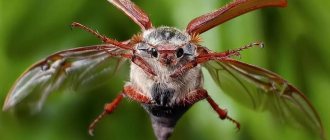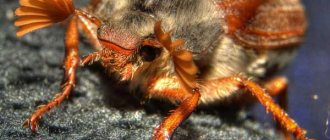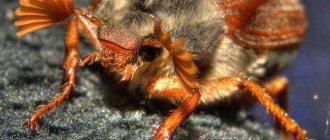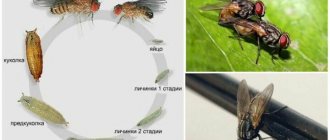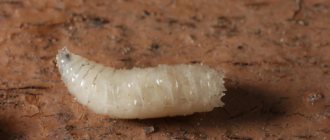The housefly (in Latin the name of the insect sounds like Musca domestica) is considered the most common among the numerous representatives of the class.
Fly sitting on a flower
In zoology, it is customary to distinguish two types of winged insects: typical and southern houseflies.
The latter is distinguished from the indoor subspecies by its larger size. Let's consider the structural features of the housefly, how the wings and mouthparts of the insect are arranged
Description and anatomy of a fly
Flies are insects from the order Diptera. They are distributed in all corners of the planet, with the exception of Antarctica. According to various estimates, from 150,000 to 200,000 species of flies live on Earth. Some of them live in the wild, others are synanthropic species, that is, their life is directly related to humans; a small part of these insects are parasites.
Structure
How much a fly weighs and what its size depends on the species of the insect. Thus, body size can vary from 1-2 mm to 5.5–6 cm, with the vast majority of flies growing from 8 to 20 mm. The average weight of a fly is 12 – 16 mg.
Project “Lifestyle of a Fruit Fly”
Experiment on phototaxis, geotaxis and chemotaxis in Drosophila.
The fruit fly is often the subject of study in ethology, the science that studies the innate behavior of all living organisms. The same type of behavior of one type of organism, which is their reaction to an external stimulus, is called taxis. In this experiment, you will explore phototaxis, geotaxis, and chemotaxis in fruit flies.
What we need:
- 4 tall empty plastic bottles;
- scissors;
- transparent tape;
- fruit flies (wild type fruit flies);
- fridge;
- clean table;
- black thick paper;
- funnel;
- cotton wool;
- sugar;
- salt;
- baking soda;
- fresh fruits (unripe and overripe);
- vinegar;
- water;
- other products for research.
Progress of the experiment:
- Before you start the experiment, you need to let the fruit flies slow down a little. To do this, place them in the refrigerator for 15-30 minutes;
- Between experiments, give the fruit flies a few minutes to rest;
- Now we need to connect two bottles: Using scissors, cut off the bottom of all plastic bottles;
- Place one bottle into the empty bottom of another bottle; Secure them with tape;
- Seal the necks with cotton wool;
- Make an identical second camera.
Phototaxis experiment
Attach black paper to one side of the first chamber; Carefully introduce 6-20 fruit flies through one of the spouts; Place the camera on its side; Wait about 20 minutes; Count how many fruit flies are in the light part of the bottle. Subtract this number from the total to determine how many ended up in the dark part; Record the results.. Phototaxis experiment with flies.
Phototaxis experiment with flies.
Geotaxis experiment
- Place 6-20 fruit flies into the second chamber;
- Hold this camera vertically for 10 minutes;
- Count the number of fruit flies in the bottom half of the bottle;
- Compare this number to the number of fruit flies in the top half of the bottle;
- Record your results.
Geotaxis experiment with flies.
Chemotaxis experiment
- If you plan to use dry substances such as baking soda or sugar during your next experiment, first dissolve a spoonful of each in water;
- Place 5-10 drops of the substance you are interested in onto separate cotton balls;
- Place a cotton ball soaked in one of the substances to be tested at one end of the bottle. The other end of each chamber should be covered with a cotton ball soaked only in water. Consider why a cotton ball soaked in water is used;
- After 10 minutes, count how many fruit flies are on each side of the chamber;
- Record your results.
Chemotaxis experiment with flies.
- Drosophila more often exhibit positive phototaxis, in other words, they move towards the light;
- They show a strong negative geotaxis and like to move upward;
- During the chemotaxis experiment, you will notice that fruit flies have a strong preference for sweet foods and vinegar, which can be found in rotting fruit, their favorite food.
External structure
The structure of a fly, regardless of what species it belongs to, is the same as that of other insects. The body consists of a head, chest and abdomen. She has two main wings and three pairs of limbs. The body shape is cylindrical, can be denser or slender, elongated. Flies are insects with pronounced sexual dimorphism - the structure, appearance and size of males and females are noticeably different (most often females are larger).
Fly head
The fly's head is rounded, most of it is occupied by large bulging eyes. The forehead is located between the eyes (the distance between the eyes in females is most often greater than in males). At the bottom of the forehead are the olfactory organs - antennae. And on the lower part of the head there is a fly’s mouthparts - in the form of a proboscis. By the way, the senses (taste and smell) in flies are much better developed than in humans.
Eyes
The visual organs of flies have a complex structure. Each eye is made up of approximately 4,000 facets (bulging hexagons). Each facet perceives a small part of the object, and the brain combines all the parts, forming an overall image like a mosaic. Thanks to this feature, the fly has almost all-round visibility. She sees not only what is in front of her or to the side, but also what is happening behind her.
In addition to the main pair of eyes, many varieties of flies have three more simple eyes, which are located in the crown area.
Mustache
The antennae of a fly consist of 3 segments. They are very sensitive and can detect odors from long distances. Insects react even to very small concentrations of the substance. With the help of smell, flies find food, and females easily determine where the nutrient substrate is located on which they can lay eggs so that the hatched larvae immediately begin to feed.
Proboscis
The proboscis of a fly is an organ that unites all parts of the mouth, namely the tongue, upper and lower lip. The mouthparts of flies are of the sucking, licking type. In most species it is soft and, when at rest, is retracted into a special recess on the lower part of the head. In blood-sucking varieties, the proboscis protrudes forward. It does not retract, is covered with a chitinous covering and is additionally equipped with solid particles with which the insect pierces the skin of the victim.
Breast
The fly's chest consists of 3 sections:
- prothorax;
- mesothorax;
- metathorax.
The mesothorax is developed much better than the other two segments. It has muscles that support the wings. On the sides of the chest there are spiracles necessary for breathing.
Appearance
Wings of a fly
Most species of flies have two pairs of wings. The first is real, well-developed wings, with a membranous structure. The second is false wings, which are called halteres. They are needed to ensure that the insect maintains balance during flight.
Orders of insects
The incredible diversity in the structure of insects allows us to differentiate them into orders so that their study can be effective. The key point of whether an insect belongs to a particular order is the structure of the mouthparts, wings and type of development. In this article we will look at the most basic orders of insects.
Remember that all insects have indirect development. Indirect development can be with complete transformation or incomplete.
Orthoptera
Representatives of this order are: grasshoppers, crickets, locusts, mole crickets. The locust differs from the grasshopper in having short antennae.
Most often they have an elongated body. The mouthparts are gnawing type. The forewings are leathery, straight, fold along the entire body, and quite narrow. The hind wings are wider than the front wings, membranous, with radially arranged veins.
Representatives: silkworm, cabbage white, night peacock, mourning moth, admiral, swallowtail, bear, moths, moths.
Diptera
Representatives of the order: mosquitoes, flies, gadflies, horse flies, midges.
The head is connected to the body through the so-called cervical region, which ensures the mobility of the head. The mosquito has a piercing-sucking type of mouthparts and very long antennae. The housefly has a licking mouthpart and short antennae.
House flies carry pathogens of intestinal infections and helminth eggs. Their white worm-like larvae develop in sewage, garbage dumps, and manure. In one summer, 6-9 generations of flies develop.
The development of dipterans is indirect with complete transformation (metamorphosis). A larva emerges from the egg, which does not resemble the adult. As a result of metamorphosis at the pupal stage, an adult individual (imago) is formed.
Hymenoptera
A number of ichneumon species are successfully used by humans as a method of biological control of flies and beetles, and caterpillars that harm crop plants.
Development is indirect with complete transformation (metamorphosis). The larvae do not resemble the adult; most have a worm-like body shape and lack walking limbs.
Beetles (Coleoptera)
Representatives: May beetle, Colorado potato beetle, swimming beetle, gravedigger, dung beetle, scarab, ladybug, bark beetle.
The gravedigger beetle does not feed exactly as its name might suggest: sensing the smell of carrion, these beetles find the corpses of animals and, by digging out the ground from under them, contribute to their burial. The beetles chew through roots and herbs that interfere with burying the corpse and feed on it. They lay their larvae in the dead tissues of the animal, which feed on the remains of the animals.
Development with metamorphosis (complete transformation), typical stages: egg, larva, pupa, imago (adult). The larvae have a gnawing type mouthpart, a well-developed chitinized head, and most have articulated thoracic limbs.
Bedbugs
I note that at the moment in taxonomy, bedbugs are a suborder included in the order Hemiptera. Representatives: bedbug, stink bug, keelweed.
The mouthparts are of the piercing-sucking type; many bedbugs are predators and parasites: they pierce the skin of an animal or the epidermis of a plant, after which they suck out blood or juices, respectively.
It is obvious that some bedbugs are blood-sucking parasites of humans; some species cause significant damage by feeding on plant sap: they deplete plants and reduce productivity.
Most bedbugs are characterized by the presence of odorous glands on their abdomen, the secretions of which have a specific odor that is unpleasant to humans. It is probably the smell that helps them scare off enemies.
Development with incomplete transformation: a larva emerges from the egg, which is externally similar to the adult organism (imago), but smaller in size.
Mayflies
Adults are characterized by an underdeveloped oral apparatus; they practically do not feed. Larvae, unlike adults, feed actively, mainly on plant remains, and have a developed gnawing-type mouthparts.
The adult individual has two pairs of mesh transparent wings, the largest of which are the front ones. At the end of the abdomen there are three or two characteristic tail filaments.
Dragonflies
Representatives: yellow, flat dragonfly, brilliant beauty, large rocker.
Characterized by the presence of two pairs of wings with a developed dense network of veins and an elongated slender abdomen. Large eyes are located on a large head, the body size is relatively large.
Development with incomplete transformation. The faces develop in water (lakes, ponds, rivers). Adults have mastered the air habitat.
© Bellevich Yuri Sergeevich 2018-2021
This article was written by Yuri Sergeevich Bellevich and is his intellectual property. Copying, distribution (including by copying to other sites and resources on the Internet) or any other use of information and objects without the prior consent of the copyright holder is punishable by law. To obtain article materials and permission to use them, please contact Yuri Bellevich
.
Source
Paws
The fly has 6 legs, each of which consists of 5 segments. The paws are equipped with developed muscles, at the end there are claws, suckers and special glands. During movement, a sticky substance is released that helps the insect stay on any surface. Thanks to this, flies can easily move along the walls and ceiling.
Abdomen
The abdomen of a fly, depending on the variety, consists of 4–10 segments. It can stretch significantly during feeding or when the female carries eggs. The abdomen also contains abdominal spiracles.
Virtuoso pilot
The chaotic movement of the front sight around the room is difficult to track. She lands on the ceiling from a loop or flip and immediately freezes in place. Just now the room was filled with its loud buzzing, and now there was silence.
Interesting!
Flies are perfectly oriented in space only in bright light. If it is turned down indoors, the insect may hit the wall or ceiling and fall.
During flight, when approaching any surface, the fly prepares to land and extends its limbs with Velcro at the ends. As soon as she is as close as possible to the obstacle, her glands securely fix her without causing injury. It can hang upside down or on a vertical surface for hours, and even in sleep the fly does not fall from the ceiling.
This method of grabbing onto any surface often saves the life of a fly. Not every predatory insect or other animal that hunted it is capable of maneuvering so deftly. But how does she tear her limbs off the ceiling if they are firmly glued? To do this, she uses a cunning method. To peel off the tip of a limb, she first peels off one side of the foot from the ceiling, then the other. This principle is familiar to everyone when peeling off tape.
Internal structure
The main internal organs of the fly are located inside the abdomen. These are the genitals and digestive organs, the circulatory system, the respiratory system and the nervous system.
Reproductive system
The reproductive system includes accessory glands, ducts, as well as testes in males and eggs in females. External appendages differ depending on the species. Most flies lay eggs, but some species are viviparous - females give birth to larvae.
Digestive system
The digestive system consists of the crop, intestines, Malpighian vessels and excretory tubules. Flies are insects with external digestion. That is, food digestion occurs outside the body, under the influence of a special secretion injected by the fly. After this, the insect sucks up the resulting liquid.
Other organs and systems
Other organs and systems of the fly's body:
- the brain is a large number of nerve plexuses that are located in different parts of the body and perform the main function of coordinating the behavior of the insect;
- respiratory system - a complex system of tracheas located throughout the body and opening outward with spiracles;
- circulatory system - includes the aorta, heart, pterygoid muscle and dorsal vessel.
Lifespan
The life cycle of a fly depends on the conditions and time of its birth. When cold weather sets in, they hide and try to wait out the difficult period. Larvae and pupae stop their development in the cool season. The first flies appear from them in the summer. Adults usually die in winter because they become infected with mold.
A person is able to shorten the lifespan of an insect at any phase. This happens using chemical and physical means. If he doesn't do this, then just one pair can reproduce more than 5 million individuals - they are very fertile.
Reproduction of house flies
Males and females participate in the reproduction process. They mate, after which the female lays eggs. Some species are viviparous, in which the female lays larvae. Up to 150 eggs or larvae are born at one time. If the insect species is oviparous, the larva is born within 24 hours. There can be up to 5-6 such clutches after one mating.
Larva
Females lay eggs in waste heaps or other fertile environments. After birth, the larvae need food and they get it from the outside, eating the waste in which they were born. The digestive juices of the fetus help liquefy food. The larvae of some species are characterized by parasitism.
After 8-10 days, the larva will collect enough nutrients and pupate. During the postembryonic period, she will have time to shed 2-3 times and increase in size. She is constantly in the process of eating food, trying to crawl deeper to hide from ultraviolet radiation and natural enemies.
Fly development
A fly can spend several days in the pupal state, and under unfavorable conditions, nutrients will help it maintain its properties for several months. As soon as it gets warmer, she will hatch. In summer, this process takes 3 to 4 days. During this time, the transformation from a larva into a young individual occurs.
Young individuals emerge from the pupa - adults. They are more active, since they need to get more food to grow than fully mature ones. By the time they reach sexual maturity, flies gain weight. They meet a male and continue to reproduce. If you wait for a couple of flies to have ideal conditions, then by the end of their life they will produce several million offspring.
How long do flies live
After you have learned all the structural features and reproduction of these insects, it is time to answer the question of how long common flies live. The ideal conditions for their residence are summer time. They show maximum longevity at air humidity of about 80% and temperature from 22 to 26 degrees. But they are able to survive under other conditions. You can meet insects at temperatures from 11 to 45 degrees above zero.
When it gets cold outside (below 11 degrees), they become less active. They begin to hibernate. This stage of development may be delayed if winter has arrived. Adults rarely tolerate it normally (they are able to survive at low temperatures for only a few days), but pupae or larvae are able to withstand this period without loss.
Under optimal conditions, the average lifespan of a fly is from 1.5 to 2 months. They can spend so much time in a room in a residential building.
How long does a female live?
A female fly in a house can live up to 2 months, regularly producing offspring. During her life she will lay at least 1000 eggs. If her breeding season occurs in winter, she will leave behind fewer offspring.
In autumn, flies begin to fly slowly, and all their vital processes slow down. If they have the opportunity to lay eggs, then the process of emergence of the larvae will be noticeable not in 24 hours, but much longer. Some of the offspring will be born only in the spring or when there is significant warming in the house.
Habitat and lifestyle
Flies are widespread throughout the planet. They can be found in hot deserts, tropical forests, temperate zones, and tundra. The housefly, the most famous synanthropic species, is considered heat-loving, but despite this, it exists almost everywhere where people live.
Where does the house fly come from and where does it live in the apartment?
Flies enter apartments during the warm season through open doors and windows. But you can find a dipterous insect in the house at any time of the year. They can enter through the ventilation system from the basement or be brought in by someone in the household. For example, fly eggs can be in the soil for indoor plants or on purchased fruit.
Larvae
In an apartment, flies settle closer to food, so they are most often found in the kitchen.
What does an insect eat?
Depending on the species, flies can eat:
- excrement;
- dead flesh;
- nectar or plant juice;
- blood of people and animals.
Some species are classified as polyphagous, meaning they eat almost anything from feces to human food.
Other types of mouthparts
Filter type
The described varieties belong to the main types of mouthparts, however, among smaller and less numerous orders there are also other modifications. For example, in some aquatic animals, the larva (or larva) is an immature phase of post-embryonic development during which the main growth processes occur in arthropods.
More details by following the link
More details by following the link
“>larvae of many midges (Simuliidae), a kind of fan develops on the head, designed to filter microorganisms. Based on the mechanism of operation, this type of apparatus is called filtering.
Cutting and sucking type
More details by following the link
More details by following the link
“>maxillae - into long piercing stilettos. Both pairs of jaws cut and pierce the integument of the body of mammals, causing bleeding from the wound. This blood is collected by a sponge-like structure on the Labium (or lower lip) - the part of the oral apparatus located opposite (behind) the upper lip and involved in eating.
More details by following the link
More details by following the link
More details by following the link
“The hypopharynx fit tightly together, creating a tube through which blood rises into the esophagus.
Tubular-sucking type
Adult Lepidoptera feed on nectar and other liquid food. It is absorbed using a long proboscis formed by folded together galea and maxillae (or lower jaws) - part of the oral apparatus of insects, the second pair of jaws responsible for grinding and/or delivering food to the mouth.
More details by following the link
">maxillae. The result is a tube that opens into the esophagus. This type of structure is called the tubular-sucking type of mouthparts.
Source
Aerodynamic properties
The flight of a fly is a unique phenomenon, the nature of which scientists still cannot fully understand. Insects move quickly, have excellent maneuverability, and change direction almost instantly.
Flight Features
The flight of a fly has several features:
- acceleration is not required for takeoff;
- hovering in the air;
- sudden change in trajectory;
- covering long distances without reducing speed;
- hard landing.
A fly can change direction many times in flight without slowing down at all. Most often they fly in zigzags.
Height
Usually flies do not need to rise high, because they mainly find food on the ground. But flies fly at a height of 7–10 floors, and if necessary they can rise higher. How high the fly rises is greatly influenced by the speed and direction of the wind.
Range and speed
The average speed of a fly is about 3 km/h, but if necessary, the insect can fly at speeds of more than 6 km/h. The flight speed of a fly depends on its size, how hungry it is, and how strong the reproductive instinct is.
But scientists have not yet been able to find out how many kilometers a fly can fly without resting. After all, usually the movement of a fly is limited to covering a short distance, after which it lands.
Flying in the rain
If you have to fly during the rain, most often the insect will not be harmed and, moreover, will remain dry. It's all about the visual characteristics of these insects, as well as the speed of reaction.
In flight
Attention! A fly in flight sees all the drops approaching it and can maneuver to avoid them.
The role of the limbs
It should be noted that a fly needs legs not only to rest between flights or to walk. Amazing fact: each limb of this insect is equipped with taste buds! As soon as a fly lands on a particular object, it immediately determines the degree of its edibility.
Attention! In addition to taste, flies also have tactile receptors on their legs. The limbs perform several important functions at once, so flies carefully monitor their cleanliness.
How do flies wash themselves?
Flies do not wash themselves in the usual sense of the word. They clean their legs and wings frequently and thoroughly. Despite the fact that flies are carriers of many diseases and are considered one of the “dirtiest” creatures, they strictly observe the rules of personal hygiene.
Why do flies rub their legs?
Anyone who has ever observed the behavior of flies has noticed how often and diligently they rub their legs against each other. The fact is that while walking, the surface of the bristles becomes dirty. Small dust particles and other debris prevent full contact of the paws with the surface.
When a fly rubs its legs, it not only cleans them, but also stimulates the secretion of a sticky secretion. Thus, this simple action provides the insect with freedom of movement.
Epidemiological significance
Sometimes the question arises whether it is possible to kill flies if they are an important part of the planet's ecological system.
Since most types of flies come into contact with waste, excrement, carrion and then with human food or objects that people touch, they mechanically transmit pathogenic microorganisms, helminth eggs, and infectious agents. In the most severe cases, a fly infestation can cause an epidemic.
Based on the above, it is impossible to coexist peacefully with flies that appear in the house; they must be killed in order to avoid unpleasant consequences.
Human interaction
Houseflies are a real nuisance to humans, especially on hot days. They are carriers of diseases, especially pathogens of intestinal infections, worm eggs, eye diseases and tuberculosis. Larvae can cause tissue and intestinal myiases
To protect against flies, preventive measures are taken (storage of sewage, which serves as both food for flies and their larvae and a source of pathogenic microorganisms, out of the reach of flies) and various exterminatory measures (use of insecticides in places where larvae develop, poisoned baits, sticky tape traps and fly swatters in those places where adult insects are abundant). Using nets and other devices, flies are prevented from entering living spaces.
Maggots are used by humans as a popular fishing bait that attracts many species of fish. Often maggots are specially bred and “cleaned” by placing them in a container with sawdust, and only then sold. Fishermen store purchased maggots in the refrigerator to slow down pupation.
Sources
- https://vseonauke.com/1120405511397706563/skolko-nog-u-muhi/
- https://apest.ru/muhi/o-muhah/stroenie-muhi/
- https://PokemonGoy.ru/muhi/skolko-lapok-u.html
- https://bioros.net/vsyo-obo-vsyom/skol-ko-nog-u-muhi.html
- https://notklop.ru/muhi/2-fakty/23-stroenie-muhi/
- https://WikiParazit.ru/babochki-i-moshki/unikalnost-lapok-muhi.html
- https://zelenplaneta.ru/muhi/est-li-u-muh-i-drugih-nasekomyh-mozg.html
- https://rci76.ru/muhi-i-moshki/kakogo-cveta-krov-u-muhi.html
[collapse]
Harm and benefit
Most people consider flies to be harmful insects. Indeed, insects cause harm because:
- carry dirt and bacteria;
- are carriers of pathogens of dangerous diseases (dysentery, typhoid, anthrax, etc.);
- spoil food;
- cause diseases in livestock.
But there are also undoubted benefits from flies, since they:
- participate in plant pollination;
- represent an important part of the food chain, being both victims and predators;
- many species are nature's orderlies, accelerating the decomposition processes of animal and plant remains.
Some types of flies are used in medicine, for example, sterile larvae of blowflies are used to treat purulent wounds. And Drosophila flies are actively used for research in the field of genetics.
Soft landing: detailed analysis
Fly on the ceiling To give a better idea of how the landing occurs and why the fall does not occur, consideration of the behavior of the individual at the moment of landing will allow. During the flight, she easily performs various complex pirouettes, which allow her to securely attach to any materials.
Interesting!
The insect does not fly forward, like many others that fly, but backward. Therefore, to kill him, you should aim a little behind.
The fly lands on the ceiling from a loop or from a flip. As a result, it transfers the center of gravity to the front and sticks to the ceiling with its paws. The rest of the body catches up with the front part and seals the fly even tighter.

